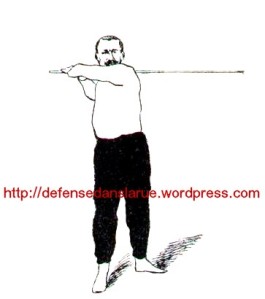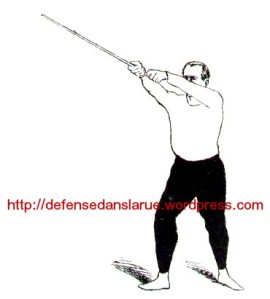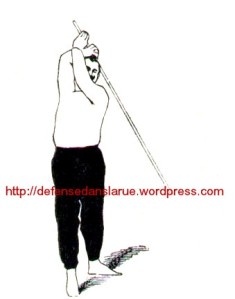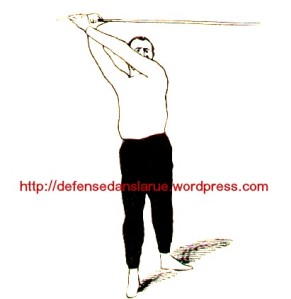Introduction:

This short article will touch on the baton as described by Emile Andre in several of his manuals which forms the original template of Defense dans la Rue.
Andre explains the two handed baton or stick is based on the principles of la canne. However due to the batons length, which measures 1.5 meters, along with its additional weight, it must be manipulated with both hands. The reach of the stick allows the point of percussion to be expanded beyond that of the cane, while its size has a demoralizing effect on single and multiple opponents.
Grip:
Gripping the baton involves placing the rear hand towards the butt of the weapon, holding it in a hammer grip with palm facing the lower abdominals. The leading hand is placed forward with the thumb running along the shaft of the stick and the palm placed upward. Both arms are flexed and the dominate hand is placed forward I.E. if you’re right handed your right side would be leading. Andre adds that some styles of baton, in particular the “Joinville” military method, will at times utilize both left and right guards.
The front hand directs the blows of the baton while the rear hand simply acts as an auxiliary, supporting the sticks manipulation. To assist in the dexterity of the left or less coordinated hand, Andre advises that some la canne practice with the less dominated arm would be advantageous.
Footwork is identical to that of la canne and comprises advancing, retiring, half-lunging and lunging.
Strikes:
Andre tells us that the actual blows with the baton are based on la canne and that both use similar principles to Saber fencing. Strikes include ‘Coup de tete’-vertical strike to the head, ‘Coup de figure’: strike to the face, both left and right sides- ‘Coup de flanc’- which includes the kidney and belly and the ‘Coup de jambe’ – strikes to the left and right sides of the leg.
Due to the batons length the blow to the wrist ‘Coup de manchette’ is delivered in the manner of a fencing “coupe” and not as a moulinet.

Andre states in his manuals that the thrust with the distal end of the baton scores much less than with the cane but it still should be included as part of your offensive arsenal, particularly as a riposte from the parry of quarte.
Compound attacks:
Compound attacks are kept very simple with all feints being projected as real attacks with conviction. Follow up strikes are usually swung under, over or to the side of the opponents parry.

Parrys:
Parry’s with the baton comprise high prime, prime, second, tierce, quarte and high quarte. Circular parries in the shape of moulinets are also employed to guard strikes targeting the side of the legs. The moulinets themselves form part of their ripostes depending on the position of the stick.



Andre’s syllabus consists of a total of 37 lessons, including combinations, stop hits, feints and ripostes. These lessons require tutelage under a professor (instructor) and Andre recommends each sequence be carried out several times prior to moving onto the next one.
While several of Defense dans la Rue’s specific weapons are antiquated by today’s standards, the training in the two handed long stick does provide solid cross over principles for larger improvised weapons.
Le Baton: The two handed long stick method of Defense dans la Rue
By Craig Gemeiner (C) 2011
NOTES
My deepest gratitude to Craig Gemeiner for his kind permission in reposting his essay to my site! Contents cannot be copied, republished or transmitted without prior consent from him.
Craig Gemeiner specializes in the study of traditional Western fighting arts, particularly Savate and its associated disciplines, and adapting them to modern use. He is one of few instructors in the world teaching ‘Defense dans la Rue’ , a system of self-defense developed in Paris during the late 1800s and has given seminars in Australia, Japan, USA, New Zealand and Italy. For an expanded background on his background, please check out: http://gemeineracademy.wordpress.com/about-us/about-craig-gemeiner/
as well as his various sites below:
http://gemeineracademy.wordpress.com/
http://www.savateaustralia.com/
http://lacannevigny.wordpress.com/
http://defensedanslarue.wordpress.com/
http://bootfighter.wordpress.com/http://www.freewebstore.org/bootfightercatalogue/index.aspx?pageid=1000146


No comments:
Post a Comment